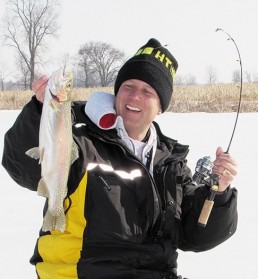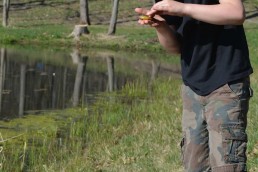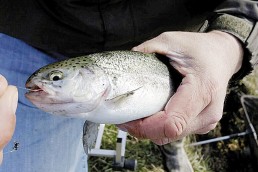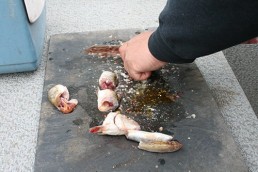Instinctive Breakthrough: Bait and Switch Epiphany
SHARE THIS POST
No matter how advanced or unskilled an angler may be, if one fishes often enough, it’s likely at some point a previously unrealized tactic will be discovered.
These breakthroughs may be painstakingly sought by hours of meticulously documented research in carefully monitored situations by well-seasoned, scientific minded individuals, or, more often than many admit, by someone with minimal experience accidentally stumbling upon a revolutionary concept. We’ve all seen it happen—that’s fishing.
At times, these revelations take place in obvious fashion right before our eyes. Once recognized, it’s easy to take full advantage of the opportunities provided. Yet, oddly enough, many ice anglers often don’t realize progressions being made even as they’re occurring, and consequently aren’t able to use them effectively or consistently enough to improve productivity.
I have to admit the latter has happened to me. On a recent trip, I unconsciously began using an ever so slight, instinctive modification involving my jigging cadence that was bringing success. But with my eyes focused intently on my Vexilar watching for fish and the depth they were coming through—all while trying to identify the prime strike zone and monitoring a variety of physical variables, tackle and bait choices—I completely overlooked recognizing this nuance.
To be honest, I never actually deciphered it on my own. It took a friend observing me discreetly from a distance to say, Aha, so that’s what you’re not telling me! Then it clicked.
Despite my best effort to give him credit for the discovery, to this day, he still thinks I was holding out on him.
The same can be said for any number of additional presentation details that can easily be overlooked by an unassuming angler. For example, consider the minuscule affect a slightly different lure shape has upon movement. Often, credit is given to a particular design, without really evaluating why.
Note it may not be the lure itself getting results. Sure, it’s entirely possible the lure resembles natural forage in terms of size, profile or color. But at times, minute variations in shape combined with a unique cadence have a slight, yet distinct influence offering a critical difference in productivity. By recognizing and keying in on such things, you may not only find similar lure designs or peculiar techniques equally or more effective, but perhaps you can develop a completely new, revolutionary strategy.
Ironically, such epoch moments can be exposed completely by accident. A few years ago, while fishing walleyes, that little V-shaped, clear plastic lip located on the backside of a swimming minnow cracked and snapped off while I was pounding the lure on a rocky bottom. However, since I had walked some distance to explore a new area and neglected to bring my tackle box along, I didn’t change lures. Instead, I continued fishing the damaged lure—and I also continued catching fish.
Eventually out of bait, I took the time to walk back, gather my tackle, re-rig an undamaged swimming minnow and return to the same hole. However, even though fish were still working the area, things slowed down. Just on a whim, I switched back to the damaged lure—and yes, you guessed it—I quickly resumed catching fish. Turned out the “lessened” swimming action created by the “damaged” lure was helping trigger those fish, and it’s a trick I’ve added to my repertoire. I’ve productively used this in similar sets of conditions ever since.
A particular dressing may have a similar effect.
Observant anglers paying attention to such details can learn to capitalize on them. The slight “breathing” motion of rubber legs (the original plastics), threads of marabou, bucktail or plastic tentacle-action tails may all help trigger fish—or again, provide hints as to what other types of dressings might be equally or more productive.
Something as simple as changing a knot type may be critical. Using a loop or Palomar instead of an improved clinch may seem like a minor modification and appear to have only slight influence, but the net effect upon the overall presentation may actually promote a faint, yet very meaningful result, increasing success.
The position of your knot on the lure eyelet can bring surprising results as well. Tightening an improved clinch knot on the back side of a jigging minnow eyelet will cause the bait to hang head down with the tail tilted up, allowing you to bump bottom with the lure face and realistically represent a baitfish feeding off bottom, all while placing the hook in an angled, upright position to help increase hooking efficiency. Makes sense—yes. (The guide who originally showed me this trick learned it by accident when his knot mistakenly slid out of place. Turns out he was sharp enough to recognize the advantage.)
Are you enjoying this post?
You can be among the first to get the latest info on where to go, what to use and how to use it!
Often, these subtle, “change-up” forms of the bait and switch tactic provide the edge needed to catch more fish. Other times, it’s implementing a much more literal form of the bait and switch strategy that makes all the difference.
This typically involves starting with a lure you’ve discovered is successfully attracting fish, yet for some reason isn’t consistently triggering strikes. Rather than missing out on significant opportunities by theorizing a specific lure isn’t performing well enough and must be exchanged, you instead take advantage of an obvious benefit by not switching, and continuing to work that same lure to draw fish.
What you will do differently, however, is have other designs of varied nature pre-rigged that can be efficiently lowered to produce strikes after the first lure effectively draws them in.
Not following?
Well, say you’re fishing a swimming minnow that’s consistently attracting fish and getting attention—but try hard as you may—isn’t consistently triggering strikes. This is where the literal translation of the bait and switch technique comes in. If you find the fish fairly active and not too deep, try quickly pulling the swimming minnow up, grab a second rod rigged with a flat-bottomed swimming jig that moves a tad differently than the swimming minnow, and see if that will tease a strike.
If the fish aren’t very aggressive or you’re fishing deeper, you may want to save time by simply setting that first system down and allowing the swimming minnow to drop to bottom, then grab the second system and lower the new presentation. Keep in mind when using this strategy that it’s a good idea to have a second hole drilled to accommodate the second line, as this helps prevent tangles if a fish is hooked.
This tactic can become even more effective when taken a step further: You might try using a larger, more aggressive presentation to draw fish in, then try downsizing or slowing things down a bit to trigger strikes. When fishing walleyes or lake trout, for example, this might mean going with a flashy, relatively heavy-bodied spoon and jigging rather aggressively to cover water and generate attention before lowering a more naturally colored, action plastic-tipped jig head or a much slower falling tube jig to garner strikes.
After catching a fish, switch back to working the initial “attraction” lure to call another fish in, and when one approaches, repeat the performance by lowering and working that secondary “trigger” bait—this is a productive, multi-species tactic.
Case in point:
While fishing white bass a couple seasons ago, a small swimming jig and minnow head combination was getting interest and bringing fish in, but wasn’t instigating consistent strikes. After several hardcore attempts, I took out a secondary rod rigged with a Marmooska Tungsten Dancer, tipped it with several maggots, and positioned it directly at my side—the lure dangling in the minnow bucket to prevent the grubs from freezing. Whenever fish moved in for a look, but wouldn’t strike that swimming jig, I’d quickly retrieve it, grab the secondary rod and drop the dancer down. The smaller, slower falling flash lure often resulted in an almost immediate strike, raising my productivity significantly. (The fishing the Dancer alone did not maintain the same level of efficiency; it simply wasn’t generating the same amount of attention and bringing in fish the way the swimming jig was. Yet, the Dancer was the trick to generating strikes.)
It took the increased movement, and flash and activity of the swimming jig to provide the draw of the more subtle motion of the Dancer to trigger a response.
I’ve experienced a myriad of instances where using improvised “bait and switch” strategies significantly improved catch rates over simply making a total presentation change. When you think about it, this makes perfect sense, because you’re able to take full advantage of two very distinct worlds: the powerful, appealing attraction offered by a particular lure, feature, or tactic and its ability to call fish in, and the irresistibly enticing temptation of a secondary lure or presentation wrinkle that causes fish to strike.
That’s what I call the bait and switch epiphany.
Tom Gruenwald has contributed to the modern “ice fishing revolution” over the years by authoring hundreds of magazine articles and four books on the subject, all while spending countless hours promoting the sport through his seminars, appearances and award-winning television program, TGO, Tom Gruenwald Outdoors, now airing on Sportsman Channel, Wild TV and Midco Sports.
MWO
SHARE THIS POST
Did you enjoy this post?
You can be among the first to get the latest info on where to go, what to use and how to use it!
Tom Gruenwald
Tom Gruenwald has penned hundreds of informative ice-fishing articles and blogs, been a frequent and popular guest on outdoor speaking circuits, radio and television, has authored four ice-fishing books, and formerly hosted Tom Gruenwald Outdoors, a nationally syndicated television show dedicated solely to the sport of ice-fishing.




